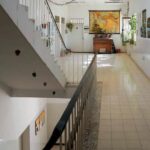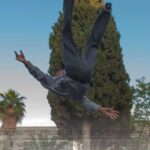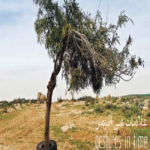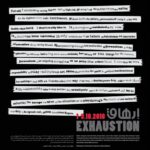
Previous Programs
The Jerusalem Show
The Jerusalem Show is neither a biennial nor a one-time event. It is neither a large-scale show nor an international grand exhibition. We like to see it as an attempt to intercede between the apocalyptic tides of upheaval under which the city kneels, stealing time during the ebb of violence to wage an action of covert resistance…” Ideas about staging a major contemporary art event in the Old City of Jerusalem had been talked about at Al Ma’mal since the 1990s, but finances, time and events had mitigated against realising such a proposition. It was not until Al Ma’mal had been successfully operating for some years, and after the interruptions of the Second Intifada, that the idea could be given more serious attention. The inaugural Jerusalem Show opened on 20 October 2007, taking place in different locations in the Old City for ten days. Organised since on an annual and later a biennial basis, the Jerusalem Shows – through exhibitions, performances, workshops, screenings, talks and guided tours – have taken the entire Old City as a venue and contextual starting point, with each edition unique and varied in its interpretations. Following the instigation in 2012 of the Qalandiya International (Qi) project,[1] a collaborative initiative of cultural organisations across historical Palestine, and further afield, the Jerusalem Show became a biannual event as one of the exhibitions and programmes in the Qi framework.
In its English title, ‘the Jerusalem Show’ borrows from the naming of popular and longstanding American TV shows such as the Muppet Show or Saturday Night Live, implying entertainment, fun, and clever political satire and comedy. In contrast, the Arabic title (’Ala Abwab Al Janna), translates as ‘Outside the Gates of Heaven’, referencing the venerations that are bestowed on the city, and the dichotomies between those histories and perceptions and the realities of lived experience. These two sides of the coin, as it were, have both played their part in all the Jerusalem Shows that have followed the inaugural 2007 edition.
Negotiating and producing such an event in this city and the wider context requires navigating some complex terrain; it necessitates collaborative partnerships, colluding with some and being persuasive with others. Uncharted, and non-negotiable, territories need to be skirted around, and superficial attempts at ‘dialogue’ or ‘engagement’ avoided as problematic and ultimately leading nowhere. For a short time in the annual calendar of celebrations and events that mark the rhythms of time in the city, the Jerusalem Show subtly but insistently becomes another of the hidden and curious attributes of the ancient city – if a temporary and very contemporary one.
For the visitor, seeking out and touring around the exhibition venues can lead to ancient subterranean hamams or bathhouses, rooms or passageways, storefronts or cafes, old libraries and hotel rooms and corridors, into internal and external spaces normally hidden from the public eye. The works of art that can be found in these unique and special spaces lift the weight of the particular context of this troubled city a little, bringing some fresh air to the frequent sense of claustrophobia and a means of release from the tensions. Instead of simply installing and presenting works of art as aesthetic space-filling, the Jerusalem Shows steal some time and space for a different form of activism. They enact a form of covert resistance to the enforced impositions of a distorted narrative – a resistance that manifests in poetic and playful, creative and discursive interpretations and reflections.
By 2007, Al Ma’mal had been operating for almost ten years and had established a presence in Jerusalem and the region, as well as internationally, with a programme of activities and a network of artists, connections and collaborative relationships. In some ways, therefore, the first Jerusalem Show was a way of summing up Al Ma’mal’s work up to that point, and especially of its activities in that particular year. The idea of making it an annual event seemed a natural development.
[1] Qalandiya International (Qi for short) was initiated in 2012 by a group of Palestinian cultural organisations and artists’ collectives in Jerusalem, the West Bank, Gaza, Haifa and Nazareth. Rather than a scattered calendar of existing event programming across increasingly divided communities, it aimed to create a collaborative force for cultural practice in defiance of Israel’s long-standing military occupation. Organised on a biennial basis, it aims to be an attempt at unity and cooperation, and to strengthen and energise cultural life, with exhibitions, screenings, performances, talks, symposia, and more, taking place across Palestine and further afield. The core partners in 2012 were Al Ma’mal, the A.M. Qattan Foundation, Palestinian Art Court–Al Hoash, the International Academy of Art Palestine, Riwaq Center for Architectural Preservation, and the Khalil Sakakini Cultural Centre.
Camp
We believe that a contemporary art museum must be a flexible, living organism, an expanding space that will facilitate the realisation of cultural projects, empower creative individuals and avoid stagnation. Hence we envision CAMP’s essence not as a physical place, but as a real and fluid entity, a nomadic site where dialogue, growth and experimentation are encouraged.” The history of Jerusalem and of colonialism and occupation in Palestine has not been conducive to creating the conditions for establishing and ensuring the continued existence of any contemporary art museum or museums. Such centres elsewhere, in any case, are usually based on models that arose in very different contexts and which often developed out of the museums whose roots were in European colonising practices and the expansion of capitalism in Europe and North America in the nineteenth century.
In the Palestinian context, the creation of other kinds of places and spaces in which the visual arts can find a home and thrive has been necessary. But this does not mean that there have not been dreams and imaginings of the form or forms that such institutions might assume. The divided Palestinian geography and society, the constraints on freedom and the obstacles to instigating and acting on any such dreams, as well as the basic impracticalities of acquiring land and building, and especially in Jerusalem, mean the need to imagine alternatives to the models that have come into existence elsewhere but which can still perform a similar role and function, and perhaps a more vitally necessary one.
Ideas of an actual ‘collection’ or ‘museum’ of contemporary art began to be more consciously formulated at Al Ma’mal around 2004–05. Since the first Gallery Anadiel opened on Salah Eddin Street in the early 1990s, a collection had been gradually accumulating of works donated to the gallery, and then to Al Ma’mal, by the artists who had exhibited in the gallery and/or been artists-in-residence with Gallery Anadiel and Al Ma’mal. Not having the resources or infrastructure that a museum or centre might have elsewhere, especially with regard to staffing levels, curatorial programming, conservation, storage and display, required more flexible thinking about the purposes of a collection and about how such a collection could serve as a resource for greater understanding of contemporary visual art and culture both in Palestine and abroad.
The conceptual elements of CAMP as a collection not on permanent display, or catalogued and stored in climate-controlled storage facilities, but as nomadic, unfixed and flexible, began to take shape. The ‘space’ of CAMP is not a built, constructed one; it has no physical home. It is more a concept, an idea – but with a unique reality of its own. It is a collection of still and moving images, documentations, soundworks, drawings and paintings, artists’ books, material objects, as well as things/installations which exist as ideas to be remade. Non-static and relatively ‘uncurated’, it can be added to at any time. The works in CAMP come out of a specific network and constellation around Gallery Anadiel and later Al Ma’mal’s programme of exhibitions and residencies since the early 1990s. They bear witness to a range of practices, individual artists and events, and are a legacy and testament not only to Al Ma’mal and the artists who have associated with it but to a historical timeline in Palestine itself. A proper consideration and more opportunities for display of the collection still await, but its role as an agent in the ongoing and future assessments of Palestinian contemporary visual culture remains latent.
One of the foundational ideas for CAMP was to establish partnerships with existing institutes or museums abroad, to find temporary homes in host museums, to foster co-organising and co-operation projects and create more opportunities for potential exchanges, discourse, learning and engagements. This would also facilitate a continued and ongoing life for the collection, and generate more connectivity and cross-fertilisation. There have been partnerships so far with Van Abbemuseum, Eindhoven (the Netherlands) and M HKA, Antwerp (Belgium). And there remain many options for CAMP as a flexible, fluid, non-fixed entity – for it to grow and develop, be a resource for exhibitions and other projects at home and internationally, and a baseline concept for new networks and possibilities.

The Jerusalem Show IX: Jerusalem – Actual and Possible
Curated by Jack Persekian and Kirsten Scheid Partners and venues:...
Read MoreJerusalem Show VIII: Before and After Origins
Curated by Vivien Ziherl Partners and Venues African Community Centre...
Read MoreJerusalem Show VII: Fractures
Curated by Başak Şenova Assistant Curator: Begum Satiroglu Partners and...
Read MoreJerusalem Show VI: Gestures in Time
Curated by Katya García Antón and Lara Khaldi. Produced in...
Read MoreJerusalem Show V: On Off Language
Curated by Lara Khaldi and José A. Sanchez Partners and...
Read MoreJerusalem Show IV: Exhaustion
Curated by Jack Persekian, and in collaboration with Palestinian Art...
Read More





